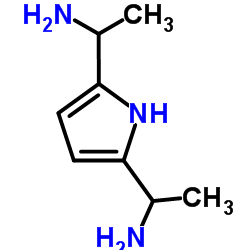1,1'-(1H-Pyrrole-2,5-diyl)diethanamine

1,1'-(1H-Pyrrole-2,5-diyl)diethanamine structure
|
Common Name | 1,1'-(1H-Pyrrole-2,5-diyl)diethanamine | ||
|---|---|---|---|---|
| CAS Number | 9003-53-6 | Molecular Weight | N/A | |
| Density | 1.1±0.1 g/cm3 | Boiling Point | 293.4±30.0 °C at 760 mmHg | |
| Molecular Formula | (C8H8)n | Melting Point | 212 °C | |
| MSDS | Chinese USA | Flash Point | 156.3±11.8 °C | |
|
Characterizing the structure of lipodisq nanoparticles for membrane protein spectroscopic studies.
Biochim. Biophys. Acta 1848(1 Pt B) , 329-33, (2015) Membrane protein spectroscopic studies are challenging due to the difficulty introduced in preparing homogenous and functional hydrophobic proteins incorporated into a lipid bilayer system. Traditional membrane mimics such as micelles or liposomes have proved... |
|
|
Effect of asymmetrical flow field-flow fractionation channel geometry on separation efficiency
J. Chromatogr. A. 1217(24) , 3876-80, (2010) The separation efficiencies of three different asymmetrical flow field-flow fractionation (AF4) channel designs were evaluated using polystyrene latex standards. Channel breadth was held constant for one channel (rectangular profile), and was reduced either l... |
|
|
Transformation of unipolar single-walled carbon nanotube field effect transistors to ambipolar induced by polystyrene nanosphere assembly.
ACS Nano 2(12) , 2526-30, (2008) We have fabricated single-walled carbon nanotube (SWNT) field effect transistors (FETs) with molybdenum source and drain contacts. Normally, these devices operate only as p-channel transistors, however, after polystyrene latex nanospheres were attached to the... |
|
|
A new measure of molecular attractions between nanoparticles near kT adhesion energy.
Nanotechnology 20(27) , 275701, (2009) The weak molecular attractions of nanoparticles are important because they drive self-assembly mechanisms, allow processing in dispersions e.g. of pigments, catalysts or device structures, influence disease through the attraction of viruses to cells and also ... |
|
|
Study of colloidal particle Brownian aggregation by low-coherence fiber optic dynamic light scattering.
J. Colloid. Interface Sci. 376(1) , 322-6, (2012) The aggregation kinetics of particles in dense polystyrene latex suspensions is studied by low-coherence fiber optic dynamic light scattering. Low-coherence fiber optic dynamic light scattering is used to measure the hydrodynamic radius of the aggregates. The... |
|
|
Isotropic photo-decomposition of spherical organic polymers on rutile TiO₂(110) surfaces.
Nanotechnology 22(15) , 155705, (2011) We observed the photo-decomposition process of polystyrene latex (PSL) spheres on a rutile TiO₂(110) single crystal surface by using atomic force microscopy. During the decomposition process, both the height and width of the PSL spheres linearly decreased wit... |
|
|
Phagostimulatory effect of uptake of PLGA microspheres loaded with rifampicin on alveolar macrophages.
Colloids Surf. B Biointerfaces 87(2) , 293-8, (2011) Our previous results on the phagocytic activity of alveolar macrophages (Mϕs) toward poly(lactic-co-glycolic) acid microspheres (PLGA MS) loaded with the anti-tuberculosis agent rifampicin (R-PLGA MS) suggest that the phagocytosis of R-PLGA MS enhances the ph... |
|
|
Preparation and evaluation of differently sulfonated styrene-divinylbenzene cross-linked copolymer cationic exchange resins as novel carriers for drug delivery.
AAPS PharmSciTech 10(2) , 641-8, (2009) The differently sulfonated styrene-divinylbenzene cross-linked copolymer cationic exchange resins were prepared by oil-in-water polymerization and varied degrees of sulfonation. Several characteristics of the obtained resins were evaluated, i.e., Fourier tran... |
|
|
Synthesis of anionic sulfate functionalized polystyrene latex and protein adsorption for application as a biosensor.
J. Nanosci. Nanotechnol. 9(12) , 7171-6, (2009) Bare and surface modified polystyrene nanoparticles with an anionic sulfate end group were synthesized by emulsion polymerization for adsorption of a protein (immunoglobulin G, IgG) by passive adsorption and electrostatic attraction for application as a biose... |
|
|
A method for articulating and displaying the human spine.
J. Forensic Sci. 54(6) , 1229-30, (2009) An inexpensive and effective method for articulating a dry human spine is described. By constructing a Styrofoam spine tray, analysts can now accurately position and align each vertebra in correct anatomical order, allow for gaps because of missing vertebrae,... |